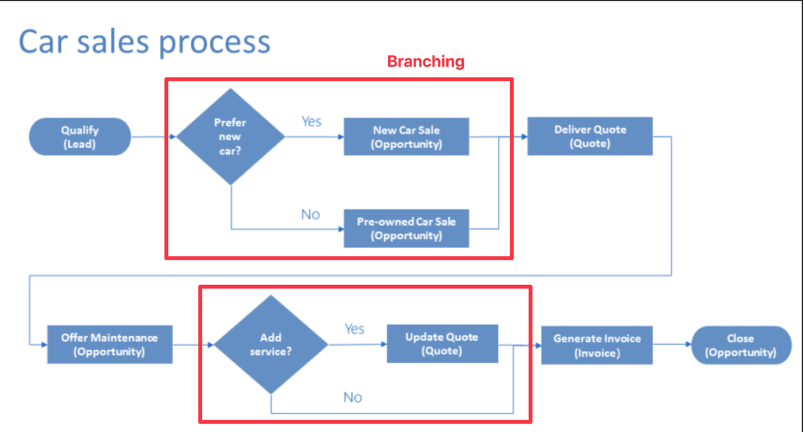Introduction
Business process flows in Dynamics 365 are a powerful tool that can help organizations streamline their operations and improve efficiency. When used correctly, they can help businesses automate repetitive tasks, ensure compliance with company policies, and provide a clear, visual representation of the steps involved in a particular process. However, to get the most out of business process flows in Dynamics 365, it's important to follow some best practices.
What about the Out-of-the-Box Sales process?
The Business Process Flow control is a visual representation of a process for which one or several related entities are following.
If we take the Sales process that is shipped with the out-of-box sales application as an example, it’s a sample process following very common patterns in how sales processes are typically designed today.
Customers may (and should!) think about what sales process your opportunities are following in real life and according to company policy, and make sure that sales process is getting implemented in Dynamics 365 as part of your implementation project. Many customers are taking the opportunity to rethink, simplify and optimize their sales process before implementing it. Some customers have even designed their sales process based on limitations of a legacy software application they were using. This is the time to rethink!
There are no firm recommendations to stick to the out-of-box sales process or claim that it’s optimized for running Dynamics 365 for Sales. Please consider this a sample and template for you to build on.
You may customize the out-of-box sales process or create your own from scratch.
Keep it simple
One of the key best practices when using business process flows in Dynamics 365 is to keep them simple and easy to understand. Complex processes can be overwhelming and can lead to confusion and errors. To avoid this, make sure that your process flows are clearly defined and that each stage is clearly labeled and easy to understand.
We usually recommend limit the number of stages and steps around the magic number 7. No disaster if it becomes 8, but we've observed numerous instances where customers implemented 25-stage processes, leading to dissatisfaction and frustration among users. The Dynamics FastTrack team is less likely to be involved in customer difficulties when the sales process is straightforward. Overly complex processes are often the root cause of frustration and adoption challenges.

Figure 1: Example Sales Process Visual
Guide the seller to the right outcome
Another important best practice is to remember that the main purpose of business process flows is to guide the seller. This means that they should be designed with the seller in mind and should be easy to use and navigate. To achieve this, it's important to consider the different types of users that will be interacting with the process flows, and to design them in a way that will be most beneficial to them.
We have seen examples of business process flow implementations where the BPF is simply a visualization of where in the sales process the opportunity is. In some cases, custom business logic is being used to drive the updates of the business process flow based on other criteria or events on or around the opportunity. This usually becomes complex and expensive for the customer to maintain, difficult for the seller to understand what’s happening, it’s not what the business process flow is designed for, and it will not simplify or help when you as a customer want to develop or extend your sales process.
Do look at the business process flow as the vehicle for guiding the seller towards the milestones of each stage and eventually to closing the deal.
Avoid common pitfalls
To ensure that your business process flows are effective, it's also important to avoid common pitfalls.
- This includes using stages that are simple reporting categories. Instead, use a more optimal method for reporting, such as a PowerBI report.
- Additionally, avoid using stages that represent ownership, as this can lead to confusion and errors. Instead, use a clear ownership model that is easy to understand and follow.
- Another feature to consider when using business process flows in Dynamics 365 is the use of branching. This allows you to create conditional stages that will only be activated based on certain conditions or criteria. This can be particularly useful when dealing with complex processes that have multiple paths or outcomes.

Figure 2: Car sales process example that includes branching.
- Finally, it is common to create steps for activity but could become ambiguous in the end whether the activity is fully completed or not. Many customers see success with dedicating BPF steps to outcome/miles achieved and using sequences to drive activity. It's important to ensure that each stage of your business process flows has steps that represent milestones. This will help to ensure that the process flows are relevant and useful to everyone involved. It's also important to avoid having empty stages, as these can be confusing and may not be relevant to anyone.
Consider other sales process features in Dynamics 365
In addition to these best practices, there are also other features that you can use to enhance your business process flows in Dynamics 365. For example, Sales Sequences can be used to enforce best practices and to ensure that your sales team is following the most effective processes. Microsoft documentation links are below:
Sales Sequences
Conclusion
Overall, by following these best practices and utilizing these additional features, you can ensure that your business process flows in Dynamics 365 are effective and efficient, and that they are helping to improve your overall business operations.



